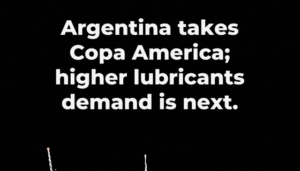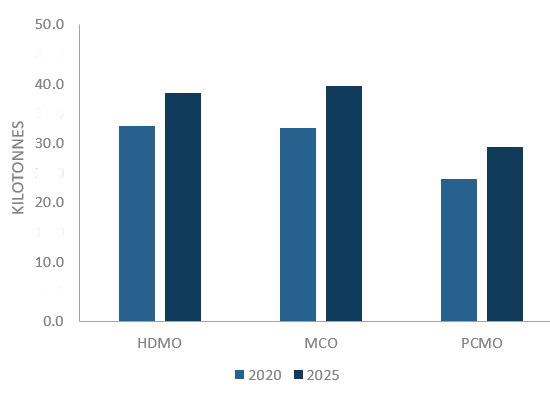
The finished lubricants market in Argentina is estimated to increase at a compound annual growth rate (CAGR) of 2.9% between 2020 and 2025 to reach 209.4 kilotonnes, according to Kline’s just-published analysis. What are the five key drivers of this impressive outlook? Where do the opportunities lie? Read on:
1. Growth of demand for finished lubricants in Argentina due to growth of e-commerce and delivery apps
Despite the pandemic, the motorcycle parc in Argentina grew by 3% in 2020. The growth in sales stems from the increased demand from e-commerce, delivery apps, and individual transportation. During the same year, 1.3 million new consumers in the country shopped via e-commerce, taking the overall user base to 20 million online shoppers. This generated delivery demand in Argentina for 164 million purchase orders for goods, an increase of 84% over 2019. According to the Global Ecommerce Update 2021, Argentina was the country where e-commerce grew the most in 2020. [1] In addition, according to consultant Focus Marketing, the use of delivery apps in the country grew by 400% from March to May 2020 due to isolation measures [2]. Finally, motorcycles were adopted by Argentines as an economic means of transportation during the pandemic. Without access to public transportation, the alternative of using a personal vehicle for a large part of the population was too expensive, as fuel prices increased 19% in the second half of the year, in addition to inflation of 36% in all other vehicle-associated expenses.
Why is this an opportunity? Prior to the 2020 pandemic, e-commerce was used by less than 30% of the population in Argentina, and delivery apps were in their infancy. The lockdown drove the need for consumers to make purchases via e-commerce to obtain essential provisions. The adoption of e-commerce and delivery apps by consumers has consolidated even after the lifting of restrictions. Between 2021 and 2025, continued inflation and lack of access to public transportation will push more consumers in the country to purchase motorcycles and scooters as a low-cost solution for delivering e-commerce orders (as part of their jobs) or to move around the cities. These factors will drive demand for MCO in Argentina at a CAGR of 4.0% through 2025, by when re-pandemic activity will return due to extensive levels of vaccination.
ESTIMATED DEMAND FOR AUTOMOTIVE ENGINE OIL IN ARGENTINA, 2020 -2025

2. Argentina’s lithium deposits
As the world turns to hybrid electric vehicles (HEV) and battery electric vehicles (BEV) to reduce CO2 emissions, Argentina has taken steps to profit from its rich lithium deposits. In August 2020, the Sustainable Mobility Law (MS) was introduced; it will facilitate an investment of USD 5 billion in the country for national production (offering tax incentives and accelerated amortization, among others, to manufacturers) to be scaled over the next 20 years. Numerous other themes are also included in the law, such as the Mobility Institute for motivating technological innovation in the vehicle industry, electro-chemical R&D (lithium), mobility R&D, and technology R&D (combustion cells, driverless vehicles, artificial intelligence, and 5G super connectivity). The law covers passenger vehicles, public transportation, and commercial vehicles. Over the next five years, the project plans to attract USD 300 million in investment, generate more than 2,000 jobs, and lead to local and international sales of USD 570 million annually.
While most lithium extraction projects in the country are in their initial phase, the Argentinian government is betting on this sector as a significant source of revenue in the coming years. President Alberto Fernández’s administration hopes to boost annual lithium carbonate production in Argentina to more than 230,000 tons by the end of 2022, a sharp rise from the current level of 40,000 tons. One of the incentives being analyzed to lure miners includes investment incentives for lithium mining, which may include a possible exemption for profit repatriation.
Why is this an opportunity? Argentina is a major source of lithium, the key component in EV batteries. According to the United States Geological Service (USGS) [3], the country has 19.3 million tons of lithium reserves. It has two projects (one on standby) that could generate 38,000 tons of lithium carbonate equivalent (LCE) intended for export. The Argentine Association of Mining Companies (CAEM) [4] expects lithium production in the country to double by 2022. As each of these projects comes to fruition, they will demand a variety of automotive and industrial lubricants for their operation.
3. High commodity prices benefitting sales of agricultural equipment in Argentina
The off-highway finished lubricants segment in Argentina includes vehicles and mobile equipment used in the agriculture, oil and gas, mining, and construction industries. The agricultural and manufacturing industries (mainly associated with food processing) were the largest consumers of industrial lubricants in the country in 2020, accounting for 18% and 17% of demand, respectively.
INDEC (Argentine Institute of Data and Census) reports that in 2020, sales of agriculture equipment units exceeded 2019 levels by 31.2%. Sales of sowing machines grew by 24.9%; tractor sales increased by 4.3%, while only harvesters suffered a minor decline of 2.1%. In 2020, the national production of tractors in Argentina posted growth of 82%. This equipment category is registering impressive growth after two prior years of recession and inflation. Many agricultural companies trade their grains with manufacturers to upgrade their equipment. It is also a way to protect their crops, which lose quality if stored too long in silo bags.
AW68 is the leading hydraulic fluid grade used specifically for its large load-carrying ability, reflecting the demand associated with heavy-duty equipment, including excavators, forklifts, cranes, combines, balers, and harvesters, as well as natural gas and air compressors.
Why is this an opportunity? In the off-highway segment, Argentina’s agriculture industry is implementing high-technology engines, especially in tractors and harvesters. These diesel engines require high-quality HDMO meeting the API CJ-4 and CK-4 service categories, both of which are compatible with Euro V standards. Owners and operators of new equipment typically follow OEM recommendations, which will drive demand for commercial automotive lubricants.
4. Chinese investment in Argentine infrastructure
China is expected to play a key role in the economic recovery of Argentina between 2020 and 2025 as President Fernández gravitates toward the Asian giant to negotiate the entry of the country in the belt and road initiative. Fernández proposed investment projects valued at over USD 30 billion in a May 5, 2021 visit to Beijing, covering sectors ranging from mining and energy to construction and agriculture.
The plan considers more than 20 projects related to energy and infrastructure which include renovation of the infrastructure of the four train lines (one specifically to transport soy from the interior to the port of Buenos Aires), the installation of intelligent pig farms, and the construction of the Nuclear IV power plant. Finally, China will invest in the mining of copper and lithium. [5]
Why is this an opportunity? Proposed Chinese investment in Argentina from 2020 to 2025 will generate more than 20,000 new jobs and require the purchase or importation of equipment specific to each industry, driving demand for automotive and industrial finished lubricants across many industry sectors.
5. Private-sector construction on the rise in Argentina
In 2020, construction represented 5% of off-road lubrication use in an industry that collapsed by 22.8% due to pandemic-related shutdowns.
Manpower Group Argentina conducted its Employment Expectation Survey (ENE) in December 2020 to gauge the outlook in Argentina for 2021. It projects the biggest growth for Argentina’s construction industry, which is expected to expand by over 10%. The 2021 rebound in the Argentine construction sector is driven by factors such as investments in public works by the government, along with tax benefits implemented to push housing construction and pandemic-related lifestyle changes that have forced people to stay at home longer and invest in works and improvements. By April 2021, Argentina’s construction industry had grown by 71% compared to 2019, with most contracted works carrying out operations as “business as usual,” with only 9% of firms still unable to perform due to COVID-19 restrictions. [6]
Why is this an opportunity? Private construction projects in residential units and logistics parks — including demand for warehousing locations to accommodate the growth of e-commerce — will sharply drive demand for commercial automotive lubricants in Argentina during the second half of 2021.
LATAM Finished Lubricants Market Overview
Beyond Argentina’s lubricants demand growth, Latin America’s finished lubricants market also offers opportunities for global and local companies looking to adjust strategic plans for the region. LATAM’s lubricants demand is rebounding, despite COVID-19 continuing to plague the region, as governments ease restrictions to recover economic activity. For example, better-than-expected passenger vehicle sales in key markets such as Mexico, Brazil, and Colombia offer a glimpse of hope. New passenger vehicle sales in Mexico recorded a first-quarter net growth of 3.3% in 2021. [7] In Brazil, accumulated sales of new passenger vehicles are up 32% compared to the prior year, [8] with sales of BEVs/HEVs//PHEVs registering the strongest quarter in history, up 29.4% in contrast to the same period in 2020. [9] Colombia also witnessed extraordinary new passenger vehicle sales, up 86.6% versus March 2020, while year-to-date sales of BEVs/HEVs/PHEVs increased 248.7% for a total of 3,651 units [10].
The mining sector in Latin America also brings good news to lubricants suppliers, as operations fire on all cylinders with silver, gold, copper and even zinc at high values. These metals represent Mexico’s, Chile’s, and Peru’s leading mining operations, and the jump in values supports Kline’s view of a projected 35% growth in Latin American mining in 2021. However, this trend may put the industry on the governments’ radar for increased taxation.
Why is this important? Heavy visgrades (25Ws, 20Ws, and 15Ws) account for 63% of PCMO in LATAM due to the average age of the vehicle parc. However, with the influx of newer vehicles, the trend will continue to move to lower viscosities (5Ws and 0Ws) fueled by the modernization of the parc, the growth of EVs, and OEM recommendations.
Although new tax impositions are more difficult to execute since most agreements between mining companies and governments are protected by international arbitration, elections in Chile, Colombia, and even Ecuador may put the mining industry under tax pressure, depending on their outcome. [11]
Click here to find out more about our upcoming report on Latin America’s Finished Lubricant Market Overview, which offers detailed data on the potential opportunities in sectors in a wide range of countries.
If you are interested in gaining knowledge of Argentina’s lubricants market beyond the five opportunities outlined in this post, CLICK HERE.
Argentina is also a part of Kline’s Global Lubricants Market Study, where its market can be included in the customized report which covers your choice of 10 country markets and/or supplier profiles and offers a comprehensive Year in Review summarizing the overall global lubricants industry. MAKE SELECTION NOW.
Footnotes:
- Argentine Chamber of E-commerce (CACE), https://www.cace.org.ar/
- Focus Marketing
- https://www.jornada.com.mx/notas/2021/06/07/economia/mexico-noveno-pais-en-reservas-de-litio-asegura-informe-en-eu/
- https://www.caem.com.ar/
- Telam https://www.telam.com.ar/notas/202009/510456-china-argentina-relaciones-bilaterales.html
- https://www.forbesargentina.com/today/cuales-son-expectativas-construccion-2021-n5062
- https://soloautos.mx/noticias/detalle/ventas-autos-mexico-abril-2021/ED-LATAM-23718/
- https://g1.globo.com/economia/noticia/2021/06/02/venda-de-veiculos-novos-no-brasil-cresce-em-maio-estoque-segue-baixo-diz-fenabrave.ghtml
- https://insideevs.uol.com.br/news/507129/carros-eletricos-vendas-brasil/
- https://autosdeprimera.com/noticias/noticias-nacionales/ventas-autos-nuevos-colombia-marzo-2021/
- AMI https://www.youtube.com/watch?v=zFf6k6bpXe4
RELATED STUDIES
Global Lubricants: Market Analysis and Assessment
This continuous publication since 2003, provides a comprehensive, in-depth analysis of automotive and industrial finished lubricant products, end-use industries, trade classes, major suppliers, and market trends in leading country markets and regions.
The customized report covers your choice of 10 country market and/or supplier profiles and offers a comprehensive Year in Review summarizing the overall global lubricants industry.
Opportunities in Lubricants: Latin America and Caribbean Market Analysis
This market study assists senior executives, product and market managers, strategic planners, raw material suppliers, and lubricant distributors assess the market for their products and understand their competition in the leading country markets in this region.
ON DEMAND WEBINAR
OPPORTUNITIES IN LATAM LUBRICANTS MARKET

The summary of key findings from Kline's previous edition. Overview of Latin American and Caribbean lubricant market. Insights into leading lubricants supplier market shares. Lubricant performance trends and demand growth.

